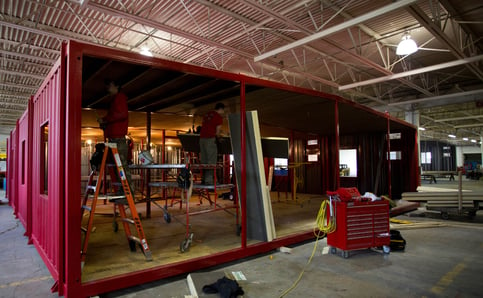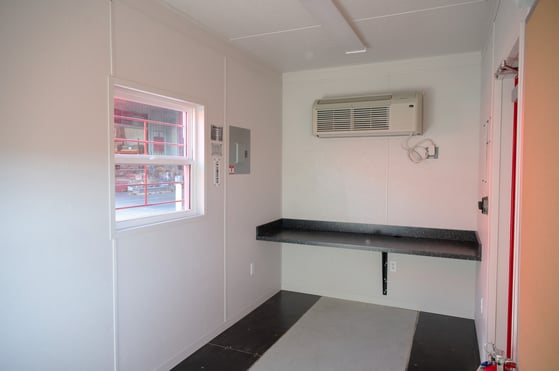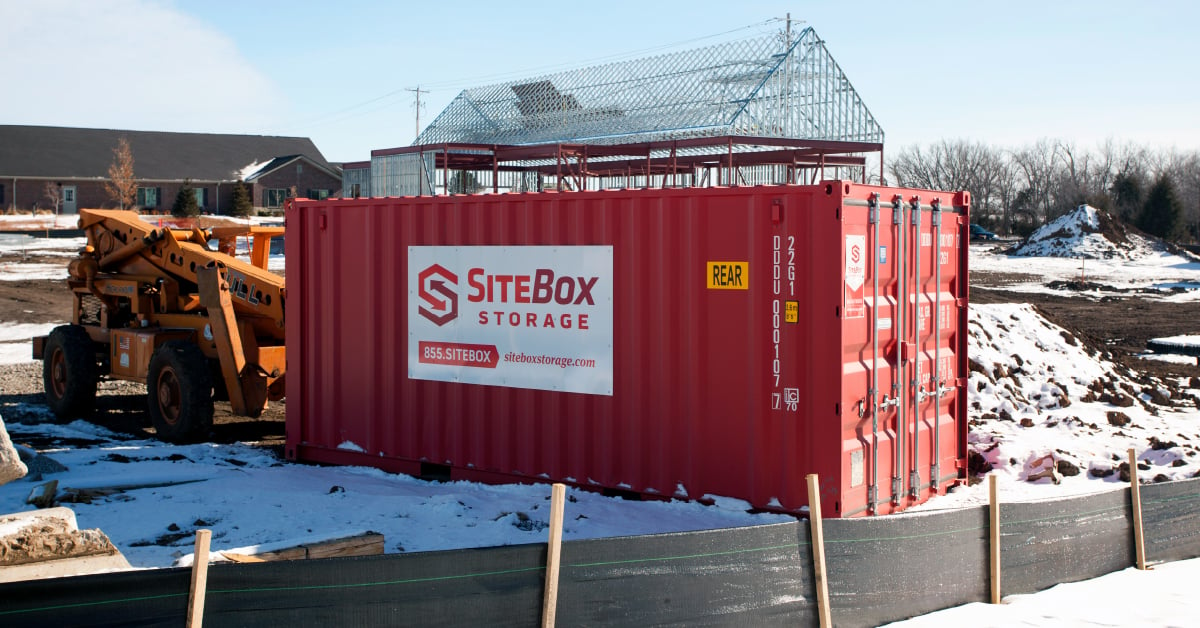accessories for onsite storage containers and mobile offices

I’ve worked around portable storage containers long enough to know one thing for sure: a few smart accessories can make a world of difference. A plain container is just that, a steel box. But when you add shelves, lighting, ramps, and a few creature comforts, it turns into something much more useful.
Over the years, I’ve seen people get creative with their setups, turning containers into clean, well-lit offices or neatly organized tool spaces. The best part is that it doesn’t take much. The right mix of accessories can make your day-to-day work easier, safer, and more efficient.
Let’s walk through some of the most practical upgrades I’ve seen customers use, and a few I’d recommend if you’re setting up your own onsite storage container or mobile office.

Why Accessories Matter
Most containers start out simple: four steel walls, a set of double doors, and a sturdy floor. That’s a great foundation, but if you’ve ever worked out of one for more than a few hours, you start noticing what’s missing.
It’s dark inside. You’re tripping over boxes. You can’t find the tool you just had in your hand. The temperature swings from freezing in the morning to sweltering in the afternoon. Sound familiar?
That’s where accessories come in. They’re not just add-ons; they’re what make a container feel like a workspace. When you set it up right, everything has a place, it’s comfortable to work in, and your gear stays protected. A few shelves and a bit of insulation can take a space from “barely usable” to “actually pleasant.”
Keeping Things Organized
If you’ve ever opened a container and been hit with a wave of clutter, you know how important organization is. The simplest solution is shelving. I always suggest starting with adjustable shelves or rack systems because they make use of vertical space and keep tools, boxes, and equipment off the floor.
Hooks and wall mounts are another easy win. You can hang hoses, cords, safety gear, or even small ladders. One customer I worked with installed pegboards across the back wall for hand tools. He said it was the first time in years he didn’t lose a wrench.

Partitions are another trick I like. If you’re using the container as both an office and storage space, putting up a divider keeps things clean and separates your work area from the messy side. Simple plywood panels work great and cost very little.
Security Upgrades You Shouldn’t Skip
Containers are built tough, but it never hurts to make them tougher. The first thing I recommend is a lock box. It covers your padlock and keeps it from being cut. They’re inexpensive and add a big layer of security.
I’ve also seen people install motion lights right above the doors. It’s amazing how a little light can scare off trouble. Some go a step further and add small alarm units or even Wi-Fi cameras that link to their phones.
If you’re storing high-value tools or equipment, consider locking rods or door bars that secure both sides of the doors. They’re simple but effective. Based on what I’ve seen on job sites, around 70 percent of people now use some kind of extra lock or security device. It’s worth it because the peace of mind alone pays for itself.
Shedding Some Light on the Inside
You’d be surprised how many people overlook lighting until the first time they need something after dark. I’ve been there myself, digging through boxes with a flashlight in my mouth. Don’t do that.
There are great options now. Battery-powered LED lights are easy to stick to the walls and give off plenty of light. If you’ve got a power source nearby, wired LED strips or fluorescent fixtures can make the space feel like a proper shop.
And if you’re running a mobile office, you’ll want outlets for computers, printers, and chargers. I’ve seen setups powered by solar panels, generators, or site power hookups. Good lighting isn’t just about visibility; it keeps everyone safer and more productive.
Climate Control and Comfort
Steel containers do one thing very well: they trap heat. That’s great in winter but brutal in the summer. So, if you plan to spend time working inside, adding insulation or climate control is one of the best upgrades you can make.

I’ve helped customers install everything from simple foam panels to full HVAC kits. Some go with small window AC units, others use portable heating and cooling systems that can move from one job to another.
Even a small vent or fan can make a big difference in airflow. Keeping temperatures stable also protects what’s inside, especially electronics, paints, or materials that don’t handle heat or moisture well.
Flooring and Accessibility
The floor inside most containers is strong, but it’s not exactly comfortable. If you’re going in and out a lot, adding plywood or vinyl flooring helps cushion your steps and protects the original steel surface. It also looks cleaner and makes sweeping easier.
For accessibility, ramps and portable steps are must-haves. If you’re moving heavy tools, office furniture, or equipment, a ramp saves your back and your patience. I’ve seen companies use folding ramps that tuck neatly inside when not in use, a simple and smart solution.
Little touches like non-slip mats near the doors make a world of difference, especially when it rains. You’ll thank yourself the first time you don’t slip carrying a toolbox.
Customization and Interior Design
Once you’ve got the basics handled, customization is where things get fun. A lot of people I’ve worked with turn their containers into full-fledged mobile offices. They’ll add desks, filing cabinets, and whiteboards, even a small fridge and coffee station.
The key is to plan around how you’ll actually use the space. If two people are sharing the office, build in a divider and give each side a desk and outlet strip. If it’s just you, open up the layout so it feels less cramped.
I’ve seen containers finished so nicely that you’d never know they started as steel boxes. A coat of paint, some trim, and decent flooring can completely change the feel of the space.
Weatherproofing and Durability
Containers are designed to take a beating, but that doesn’t mean they don’t need a little upkeep. Over time, doors can loosen, seals can crack, and small leaks can form around the edges. Adding door gaskets, roof coatings, and vent kits keeps moisture and heat under control.

In windy areas, I always recommend anchoring systems or skids to keep containers steady. For humid regions, desiccant packs help prevent condensation. These are small, affordable things that add up to a much longer container lifespan.
If you’re in a coastal or high-rain area, a little extra protection goes a long way. A simple sealant or anti-rust paint job can extend the life of your container by years.
Power and Connectivity
These days, a mobile office isn’t complete without power and internet. I’ve seen people get creative with solar panels, which can run lights and fans with zero noise. It’s a great option if your site doesn’t have regular power access.
You can also install outlets, USB ports, and small electrical panels to handle all your equipment. For teams that rely on communication, adding a Wi-Fi booster or router helps keep everyone connected.
Little things like this don’t just make work easier; they make it feel more normal. When your office has power, light, and Wi-Fi, it stops feeling temporary.
Final Thoughts
I’ve watched storage containers evolve from simple boxes to some of the most flexible workspaces out there. Accessories are what make that possible. You can start small, maybe with shelving and a ramp, then add lighting, insulation, and power over time.
What I like about this kind of setup is that it grows with your needs. A basic container can become a mobile office, a small shop, or even a breakroom with just a few upgrades. It’s all about making the space work for you.
If there’s one piece of advice I’d leave you with, it’s this: don’t wait until you’re frustrated to add the upgrades you need. Plan ahead, make the space comfortable, and you’ll end up with something that doesn’t just store your tools, it supports your work.
Frequently Asked Questions
What accessories are available for onsite storage containers?
There’s a long list. The most common are shelving units, partitions, lighting, insulation panels, ramps, and lock boxes. These are the essentials most people start with.
How do I secure my mobile office storage container?
I always recommend a lock box, a sturdy padlock, and motion lights. If you’re storing valuable gear, add door bars or a small alarm system for extra protection.
Are there shelving options for onsite storage containers?
Absolutely. Adjustable shelving and wall-mounted racks work great. They keep tools, parts, and boxes organized so you’re not tripping over them.
What lighting options can I use in a storage container?
LED strips are my favorite. They’re bright, efficient, and easy to install. For off-grid setups, go with battery-powered lights or solar options.
Can I install air conditioning in a mobile office storage container?
Yes, and you’ll be glad you did in the summer. Small window units or portable air conditioners fit perfectly and keep things comfortable.
What are the best locks for storage containers?
High-security padlocks with lock boxes work best. They’re simple, reliable, and tough to tamper with.
Are there windows available for mobile office storage containers?
Yes. You can add locking windows with weather seals for light and airflow. They’re a great upgrade for office-style containers.
How can I organize the interior of a storage container?
Start with shelves and hooks. Then label everything. It’s simple but saves you time every single day.
What safety equipment should I include in my onsite container?
Keep a fire extinguisher, first-aid kit, and non-slip mats near the door. If you’re using power tools, proper lighting and signage help too.
Can I add ramps or steps to my mobile office storage container?
Yes, and you should. Portable ramps make loading and unloading safer and faster, especially with heavy tools or furniture.
To talk about your needs for onsite storage OR a preconfigured mobile office, talk to us today!





